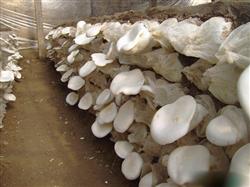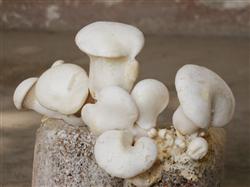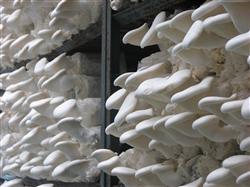Causes and control methods of mixed bacteria pollution in Pleurotus ostreatus bag?

Causes and control methods of mixed bacteria pollution in Pleurotus ostreatus bag? Please introduce that Pleurotus ostreatus is a kind of rare edible fungus with high edible and medicinal value. Its mushroom is white in color, delicate in meat and delicious in taste. It is known as "Western White Ganoderma lucidum" and "Tianshan God Mushroom". In order to produce high quality Pleurotus ostreatus, attention should be paid to the pollution of miscellaneous bacteria and timely measures should be taken in the process of artificial cultivation. I. The cause of pollution: 1. The sterilization of culture material is not complete. The sterilization of the culture material is not complete and can be found 4-6 days after inoculation. Its specific characteristics are that miscellaneous bacteria not only occur on the surface of the culture material, but also appear in different positions in the culture material, that is, the hyphae of Pleurotus ostreatus have not yet extended to reach, and the miscellaneous bacteria arrive first in the upper, middle and lower parts of the culture material. 2. The strain is not pure, with miscellaneous bacteria. If the bacteria are not pure pollution, the miscellaneous bacteria do not appear on the culture material at first, but the first occurrence on the inoculation block. 3. Pollution during inoculation. Under the condition of pure provenance, if the initial site of miscellaneous bacteria is found in the inoculation area on the surface of the culture material, this pollution is mostly caused by lax aseptic operation and bringing external miscellaneous bacteria into the inoculation. Inoculation pollution is the most common in Pleurotus ostreatus cultivation, and most of it is caused by carelessness in inoculation operation or lack of basic knowledge and skills of aseptic operation. 4. The culture material is not evenly mixed. In the process of making cultivation bags, if the culture materials are mixed unevenly or contain dry materials and lump materials during fermentation, even if the sterilization process meets the conventional requirements, it will cause incomplete sterilization and pollution. 5. Improper management during the training period. During the post-inoculation period, the air humidity of the bacteria-producing place is more than 70%, poor ventilation and high temperature will cause miscellaneous bacteria to enter and spread rapidly, resulting in miscellaneous bacteria pollution. 6. Micropore contamination appeared in the bacterial bag. Second, preventive measures 1. Purify the environment. The strain preservation room, inoculation room, culture room and cooling room should keep a certain distance from the raw material warehouse, mushroom room and batching yard, or have good anti-pollution and isolation obstacles. The surrounding environment should minimize pollution sources, such as livestock houses, poultry sheds, septic tanks, sewage pits, garbage dumps, waste dumps, etc., and do a good job of daily sanitary cleaning and regular disinfection. The higher the purification degree of the production environment is, the stricter the measures to control the infection of diseases and insect pests are, the more favorable it is to improve and stabilize the finished product rate of the bacterial bag. 2. The preparation of culture materials should be reasonable. Bagging should be rapid, the formula of the material should be reasonable, and the raw materials should not be moldy and spoiled. The culture material should be bagged in time after fermentation, and the longer the interval is, the easier it is to cause miscellaneous bacteria pollution, so it should be bagged quickly. 3. The culture material must be sterilized thoroughly. After the culture material is put into a plastic bag, it should be sterilized in time. The method of atmospheric pressure sterilization is often used in production. When the temperature in the stove reaches 100 ℃, the sterilization time should be kept for 12-16 hours, and the temperature can not be lowered in the middle. The culture bag should not be overcrowded in the stove, there should be an airway, and there should be no dead corner to kill bad bacteria. 4. the use of bacteria should be pure. For the Pleurotus ostreatus strains used in mass production, the reproduction of Pleurotus ostreatus from mother to cultivated species should be cautious, strict aseptic operation rules and careful inspection of quality to ensure the purity and robustness of the strains. 5. The inoculation should be strictly in accordance with the aseptic operation rules. Inoculation rooms, vaccination accounts, vaccination tools, vaccination personnel's arms and so on should be strictly disinfected. Vaccination action should be fast, to achieve quick release of the bag, quick vaccination, quick piercing. If the batch is not finished, do not enter or leave the inoculation room. 6. During the period of cultivating bacterial bag, the germicidal place should be managed scientifically. Clean up ahead of time and disinfect and kill insects. After the bacteria bag is put into the bacteria sending place, the air humidity should not exceed 70%, the temperature should be controlled at about 25 ℃, and it should be ventilated frequently. Avoid high temperature (more than 30 ℃), high humidity (air humidity more than 70%) and unventilated environment conducive to the growth of miscellaneous bacteria. Do not use plastic bags with microholes, handle them gently during the handling of the bags. Click to get more Pleurotus ostreatus planting techniques click to get more edible mushroom planting techniques
- Prev

How to improve the quality of planting Pleurotus ostreatus?
How to improve the quality of planting Pleurotus ostreatus? Please introduce the method of Pleurotus nebrodensis is very sensitive to temperature, its hyphae can adapt to a wide range of temperature, and can survive under the condition of 4 ℃ 37 ℃. The suitable temperature range for mushroom production is 23 ℃, 25 ℃, 8 ℃ 13 ℃ in the early growth stage and 1 ℃ in the later stage.
- Next

How to grow high-quality mushrooms?
How to grow high-quality mushrooms? Please introduce the method Want to grow high-quality Pleurotus nebrodensis can refer to the following methods: Pleurotus nebrodensis is extremely sensitive to temperature, its mycelium adaptation temperature range is wide, can survive under 4-37℃ conditions, to 23-28℃ is appropriate, the temperature range of fruiting is 0-25℃, the mushroom bud in the early stage of growth...
Related
- Fuxing push coffee new agricultural production and marketing class: lack of small-scale processing plants
- Jujube rice field leisure farm deep ploughing Yilan for five years to create a space for organic food and play
- Nongyu Farm-A trial of organic papaya for brave women with advanced technology
- Four points for attention in the prevention and control of diseases and insect pests of edible fungi
- How to add nutrient solution to Edible Fungi
- Is there any good way to control edible fungus mites?
- Open Inoculation Technology of Edible Fungi
- Is there any clever way to use fertilizer for edible fungus in winter?
- What agents are used to kill the pathogens of edible fungi in the mushroom shed?
- Rapid drying of Edible Fungi

